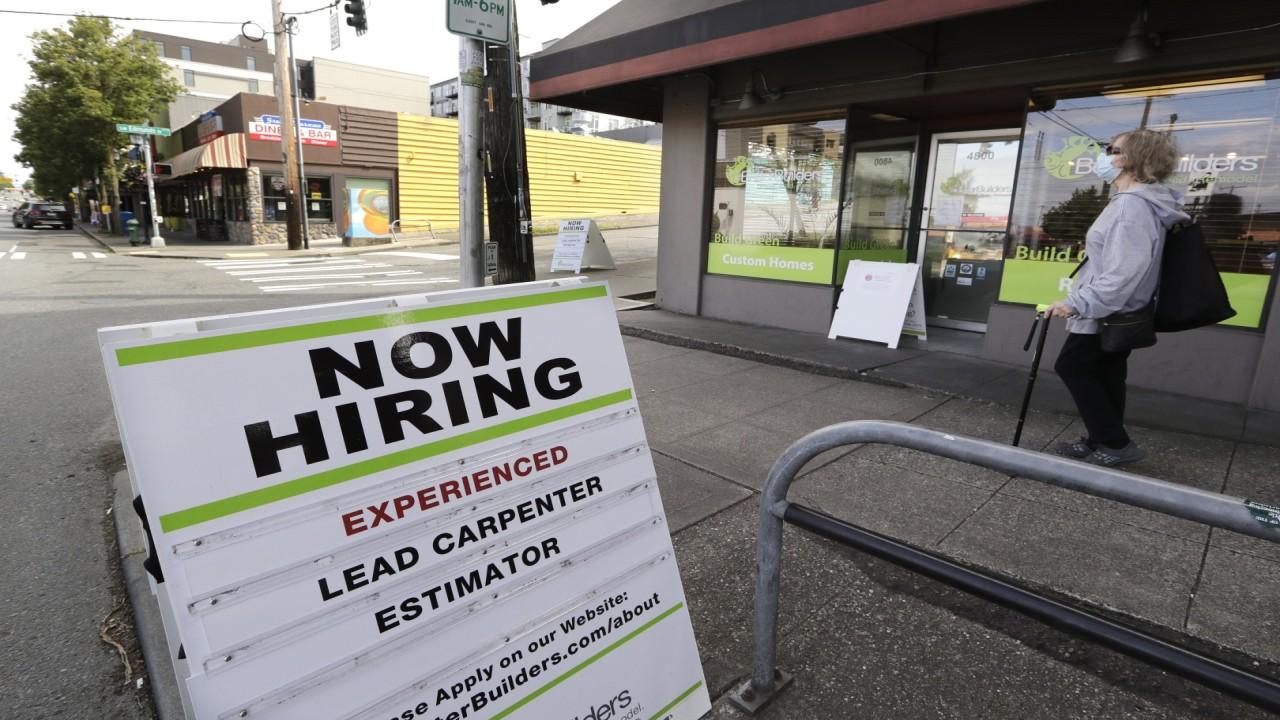Unemployment rate drops to 11.1% in June as job growth blows past expectations with 4.8M added
Economists expected the unemployment rate to edge down to 12.3% in June
The U.S. unemployment rate dropped to 11.1 percent in June as businesses shuttered by the coronavirus pandemic earlier this year rehired millions of idled workers.
The Labor Department said in its report, released on Thursday because of the Fourth of July holiday, that employers added 4.8 million jobs in June — the biggest increase on record. Economists surveyed by Refinitiv expected the report, to show that unemployment dropped to 12.3 percent and that employers added 3 million jobs.
CORONAVIRUS JOBLESS CLAIMS TOP 48M
May's figure was revised up by 130,000 for the addition of 2.7 million jobs last month. Still, the nation's jobless rate is up 7.6 percentage points compared to the start of the year, when it sat at a half-century low. There are 12 million more out-of-work Americans than compared to February.
Over the course of the past month, every state has started to navigate reopening their economies. But the unemployment level, which is still at the highest level in decades, is expected to remain elevated as social distancing guidelines remain in place, particularly as states fight a resurgence in COVID-19 cases.
| Ticker | Security | Last | Change | Change % |
|---|---|---|---|---|
| I:DJI | DOW JONES AVERAGES | 39606.57 | +419.59 | +1.07% |
| SP500 | S&P 500 | 5375.86 | +88.10 | +1.67% |
| I:COMP | NASDAQ COMPOSITE INDEX | 16708.050306 | +407.63 | +2.50% |
New cases surpassed 50,000 for the first time this week, reaching a single-day record. Arizona, Florida, Texas and California are among the states that have seen a spike in infections. If the outbreak intensifies, forcing businesses to shut down again, economists have warned the consequences could be dire.
VIRUS STILL KEEPING CLOSE TO 140,000 BUSINESSES CLOSED, REPORT SHOWS
Because the report was conducted in mid-June, it does not capture the recent closures in some states that have seen a spike in cases. Disney postponed the scheduled July reopening of its California parks, Apple re-closed 32 stores in five states, and Macy's announced that it would cut 3,900 corporate jobs -- roughly 3 percent of its total workforce. Texas Gov. Greg Abbott hit pause Thursday on the state's reopening plans, and on Friday, he ordered all bars in the state to close and scaled back restaurant capacity by 50 percent.
"Today’s jobs report is a look in the rearview mirror," said Andrew Chamberlain, chief economist at Glassdoor. "With surging COVID-19 cases hitting new highs in the past week, rough waters are surely ahead for the economy in the coming months as a second wave could again shutter millions of American small businesses and put a freeze on hiring."
Still, he said the better-than-expected report provided a "powerful signal of how swiftly U.S. job growth can bounce back and how rapidly businesses can reopen once the nation finally brings the coronavirus under control — a reason for optimism in coming months.”
WHAT HAPPENS TO YOUR UNEMPLOYMENT BENEFITS IF YOU REFUSE TO GO BACK TO WORK?
Its release comes at the same time as the Labor Department's weekly data on unemployment claims, which showed that another 1.43 million Americans filed for jobless aid last week, indicating that layoffs are continuing to mount. Continuing claims, or the number of Americans who have received aid for more than two weeks, actually increased by 59,000 to 19.3 million.
"The number of weekly unemployment claims remains alarmingly high, having barely dropped from the previous week," said Robert Frick, corporate economist at Navy Federal Credit Union. "This means that while hiring is occurring in areas such as leisure and hospitality, many are being laid off in support industries and in state and local governments"
Indeed, leisure and hospitality once again accounted for the biggest bulk of jobs created last month, with more than 2 million new positions added. About 1.48 million of those jobs were added by food services and drinking places — one of the sectors hit hardest by the pandemic as states ordered restaurants and bars to close and directed Americans to stay at home — while the accomodation sector added about 238,000.
Retail saw a gain of 740,000, and manufacturing increased by 356,000. Education and health services rose 568,000.
EXTRA $600 IN UNEMPLOYMENT BENEFITS ENDS NEXT MONTH AS MILLIONS OF AMERICANS REMAIN OUT OF WORK
But state governments, which face significant budget shortfalls as a result of the virus-induced recession, lost 25,000 jobs.
The headline unemployment number was understated slightly due to a misclassification error at the Bureau of Labor Statistics. Individuals who were temporarily out of work as a result of the virus-induced closures were still classified as employed in the report, even though they are not working and should be considered as unemployed under BLS rules.
The agency said the discrepancy "declined considerably" in June; had they been classified correctly, the unemployment rate would have been 1 percentage point higher than the reported 11.1 percent, according to the report.
During a news conference Thursday morning, Trump hailed the report as "spectacular news."

